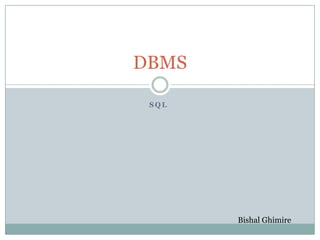06.02 sql alias
•Descargar como PPTX, PDF•
0 recomendaciones•377 vistas
Denunciar
Compartir
Denunciar
Compartir

Recomendados
Más contenido relacionado
Similar a 06.02 sql alias
Similar a 06.02 sql alias (13)
Más de Bishal Ghimire
Más de Bishal Ghimire (14)
Counseling Ethics in Astrology for better Mental Health

Counseling Ethics in Astrology for better Mental Health
Agile Intro to Manifesto - Values 1 - Interaction over Process

Agile Intro to Manifesto - Values 1 - Interaction over Process
00.00 fundamentals of database management syllabus

00.00 fundamentals of database management syllabus
Último
Último (20)
Cloud Frontiers: A Deep Dive into Serverless Spatial Data and FME

Cloud Frontiers: A Deep Dive into Serverless Spatial Data and FME
Biography Of Angeliki Cooney | Senior Vice President Life Sciences | Albany, ...

Biography Of Angeliki Cooney | Senior Vice President Life Sciences | Albany, ...
Rising Above_ Dubai Floods and the Fortitude of Dubai International Airport.pdf

Rising Above_ Dubai Floods and the Fortitude of Dubai International Airport.pdf
Apidays New York 2024 - APIs in 2030: The Risk of Technological Sleepwalk by ...

Apidays New York 2024 - APIs in 2030: The Risk of Technological Sleepwalk by ...
Apidays New York 2024 - The Good, the Bad and the Governed by David O'Neill, ...

Apidays New York 2024 - The Good, the Bad and the Governed by David O'Neill, ...
Apidays New York 2024 - Accelerating FinTech Innovation by Vasa Krishnan, Fin...

Apidays New York 2024 - Accelerating FinTech Innovation by Vasa Krishnan, Fin...
TrustArc Webinar - Unlock the Power of AI-Driven Data Discovery

TrustArc Webinar - Unlock the Power of AI-Driven Data Discovery
Connector Corner: Accelerate revenue generation using UiPath API-centric busi...

Connector Corner: Accelerate revenue generation using UiPath API-centric busi...
Apidays New York 2024 - Scaling API-first by Ian Reasor and Radu Cotescu, Adobe

Apidays New York 2024 - Scaling API-first by Ian Reasor and Radu Cotescu, Adobe
Finding Java's Hidden Performance Traps @ DevoxxUK 2024

Finding Java's Hidden Performance Traps @ DevoxxUK 2024
Emergent Methods: Multi-lingual narrative tracking in the news - real-time ex...

Emergent Methods: Multi-lingual narrative tracking in the news - real-time ex...
Why Teams call analytics are critical to your entire business

Why Teams call analytics are critical to your entire business
Web Form Automation for Bonterra Impact Management (fka Social Solutions Apri...

Web Form Automation for Bonterra Impact Management (fka Social Solutions Apri...
Apidays New York 2024 - The value of a flexible API Management solution for O...

Apidays New York 2024 - The value of a flexible API Management solution for O...
06.02 sql alias
- 1. S Q L DBMS Bishal Ghimire
- 2. SQL Alias With SQL, an alias name can be given to a table or to a column Syntax SELECT column_name(s) FROM table_name AS alias_name SELECT O.OrderID, p.LastName, p.FirstName FROM Persons AS p, Product_Orders AS O WHERE p.LastName='Hansen' AND p.FirstName='Ola'
- 3. SELECT statement without aliases SELECT Product_Orders.OrderID, Persons.LastName, Persons.FirstName FROM Persons, Product_Orders WHERE Persons.LastName='Hansen' AND Persons.FirstName='Ola'
- 4. SQL AVG() Function The AVG() function returns the average value of a numeric column Syntax SELECT AVG(column_name) FROM table_name Eg- SELECT AVG(OrderPrice) AS OrderAverage FROM OrdersTable Output OrderAverage 950
- 5. SQL AVG() Function To find the customers that have an OrderPrice value higher than the average OrderPrice value SELECT Customer FROM Orders WHERE OrderPrice > (SELECT AVG(OrderPrice) FROM Orders)
- 6. COUNT() Function Syntax SELECT COUNT(column_name) FROM table_name SELECT COUNT(*) FROM table_name SELECT COUNT(DISTINCT column_name) FROM table_name Eg SELECT COUNT(Customer) AS CustomerNilsen FROM Orders WHERE Customer='Nilsen'
- 7. MAX() Function The MAX() function returns the largest value of the selected column. Syntax SELECT MAX(column_name) FROM table_name Eg SELECT MAX(OrderPrice) AS LargestOrderPrice FROM Orders
- 8. MIN() Function MIN() function returns the smallest value of the selected column Syntax SELECT MIN(column_name) FROM table_name Eg SELECT MIN(OrderPrice) AS SmallestOrderPrice FROM Orders
- 9. HAVING Clause The HAVING clause was added to SQL because the WHERE keyword could not be used with aggregate functions Syntax SELECT column_name, aggregate_function(column_name) FROM table_name WHERE column_name operator value GROUP BY column_name HAVING aggregate_function(column_name) operator value
- 10. HAVING Clause SELECT Customer,SUM(OrderPrice) FROM Orders GROUP BY Customer HAVING SUM(OrderPrice)<2000 SELECT Customer,SUM(OrderPrice) FROM Orders WHERE Customer='Hansen' OR Customer='Jensen' GROUP BY Customer HAVING SUM(OrderPrice)>1500
- 11. O_Id OrderDate OrderPrice Customer 1 2008/11/12 1000 Hansen 2 2008/10/23 1600 Nilsen 3 2008/09/02 700 Hansen 4 2008/09/03 300 Hansen 5 2008/08/30 2000 Jensen 6 2008/10/04 100 Nilsen Customer SUM(OrderPrice) Nilsen 1700 SELECT Customer,SUM(OrderPrice) FROM Orders GROUP BY Customer HAVING SUM(OrderPrice)<2000
- 12. HAVING Clause SELECT Customer,SUM(OrderPrice) FROM Orders WHERE Customer='Hansen' OR Customer='Jensen' GROUP BY Customer HAVING SUM(OrderPrice)>1500 O_Id OrderDate OrderPrice Customer 1 2008/11/12 1000 Hansen 2 2008/10/23 1600 Nilsen 3 2008/09/02 700 Hansen 4 2008/09/03 300 Hansen 5 2008/08/30 2000 Jensen 6 2008/10/04 100 Nilsen SELECT Customer,SUM(OrderPrice) FROM Orders WHERE Customer='Hansen' OR Customer='Jensen' GROUP BY Customer HAVING SUM(OrderPrice)>1500 Customer SUM(OrderPrice) Hansen 2000 Jensen 2000
- 13. GROUP BY Statement The GROUP BY statement is used in conjunction with the aggregate functions to group the result-set by one or more columns Syntax SELECT column_name, aggregate_function(column_name) FROM table_name WHERE column_name operator value GROUP BY column_name
- 14. O_Id OrderDate OrderPrice Customer 1 2008/11/12 1000 Hansen 2 2008/10/23 1600 Nilsen 3 2008/09/02 700 Hansen 4 2008/09/03 300 Hansen 5 2008/08/30 2000 Jensen 6 2008/10/04 100 Nilsen To find the total sum (total order) of each customer. We will have to use the GROUP BY statement to group the customers.
- 15. O_Id OrderDate OrderPrice Customer 1 2008/11/12 1000 Hansen 2 2008/10/23 1600 Nilsen 3 2008/09/02 700 Hansen 4 2008/09/03 300 Hansen 5 2008/08/30 2000 Jensen 6 2008/10/04 100 Nilsen SELECT Customer,SUM(OrderPrice) FROM Orders GROUP BY Customer Customer SUM(OrderPrice) Hansen 2000 Nilsen 1700 Jensen 2000
- 16. what happens if we omit the GROUP BY statement Customer SUM(OrderPrice) Hansen 5700 Nilsen 5700 Hansen 5700 Hansen 5700 Jensen 5700 Nilsen 5700
